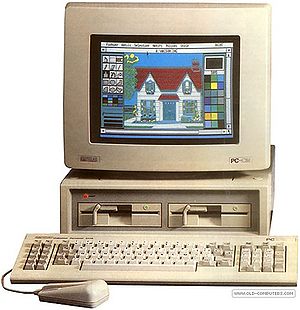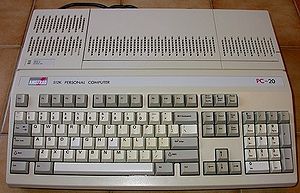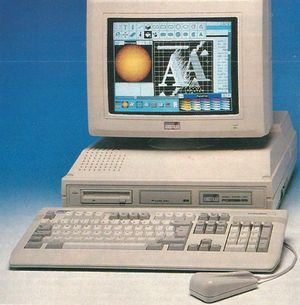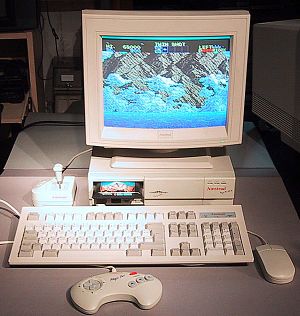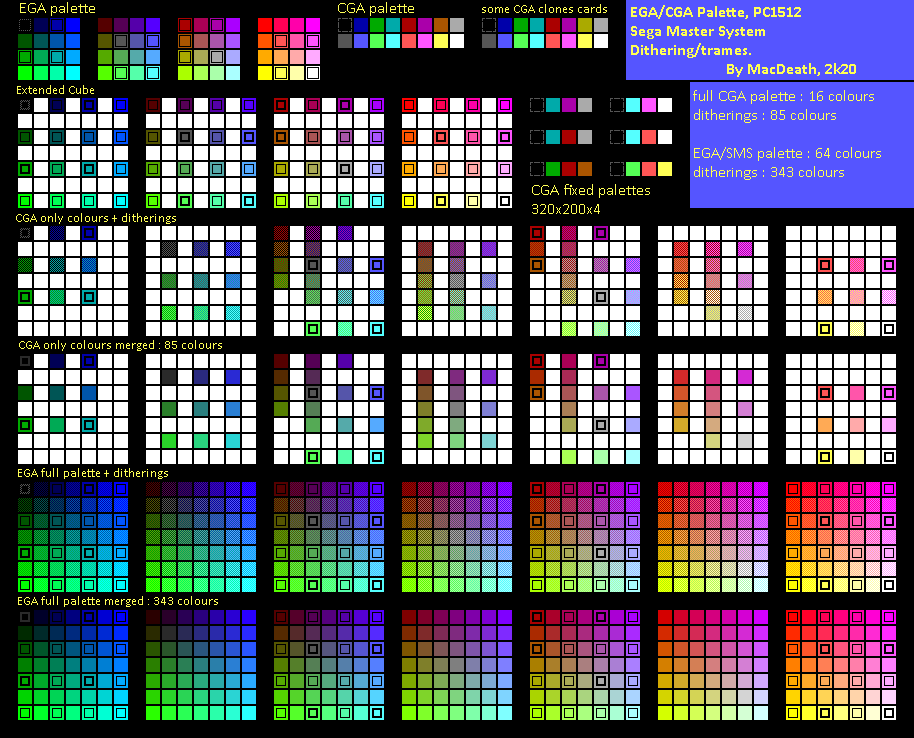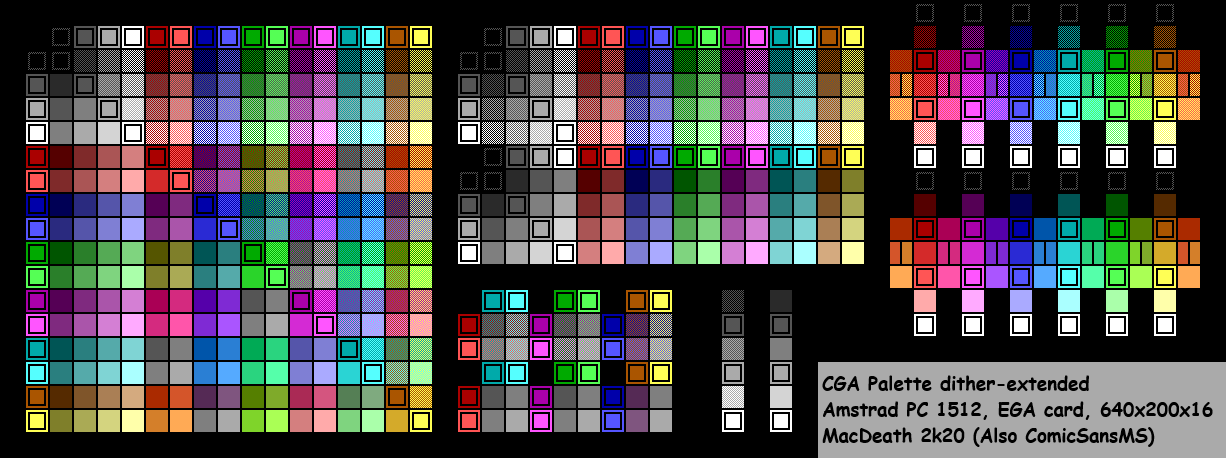Difference between revisions of "Amstrad PC"
(→CGA) |
|||
| (9 intermediate revisions by the same user not shown) | |||
| Line 1: | Line 1: | ||
[[Image:Amstrad pc1512-2.jpg|thumb|right|300px|The '''Amstrad PC1512''' - The first PC by Amstrad]] | [[Image:Amstrad pc1512-2.jpg|thumb|right|300px|The '''Amstrad PC1512''' - The first PC by Amstrad]] | ||
| + | |||
| + | [[File:Amstrad-pc1512-ad.jpg|thumb|right|300px|Amstrad PC1512 advertisement]] | ||
[[Image:Amstrad PC20.jpg|thumb|right|300px|The '''Amstrad PC20''' - An attempt to market the PC as a home computer]] | [[Image:Amstrad PC20.jpg|thumb|right|300px|The '''Amstrad PC20''' - An attempt to market the PC as a home computer]] | ||
| Line 37: | Line 39: | ||
= The video displays = | = The video displays = | ||
| − | + | VGA / EGA / CGA / Hercules graphics comparison: | |
| + | |||
| + | [[File:Prince of persia vga ega cga hercules.png]] | ||
| + | |||
| + | During that era (late 1980s to early 1990s), different graphics standards typically required their own specific monitors which were quite expensive. | ||
| + | |||
| + | Each graphics standard had particular signal timing and connector requirements: | ||
| + | |||
| + | *CGA monitors needed to handle 15.7 kHz horizontal scan rates with RGBI signals | ||
| + | *EGA monitors required support for 21.8 kHz scan rates with analog RGB signals | ||
| + | *VGA monitors needed 31.5 kHz scan rates with a different analog RGB implementation | ||
=== CGA === | === CGA === | ||
| − | + | On RGBI monitors, it enabled mostly 320x200 display with a palette of 4 colours choosen between 4 combinations from 16 total colours. It also offered a text mode with character attribute based 16 colours display. | |
| + | |||
| + | On composite monitors or TVs, composite output enabled artifact-based NTSC colour emulation, simulating more colours (typically 16 colours simultaneously, but up to 1024 colours have been demonstrated). | ||
The Amstrad CPC can quite be considered a custom and more versatile CGA. | The Amstrad CPC can quite be considered a custom and more versatile CGA. | ||
| Line 51: | Line 65: | ||
=== VGA === | === VGA === | ||
| − | The widely used VGA mode was the MCGA : 320x200x256. When those kind of display were widely available the CGA and EGA were obsolete and the PC could start to kick Amiga and Atari ST standards out of the place. VGA could also display a 640x480x16 video mode. All those from a 262,144colour total palette (6x6x6 bits). | + | The widely used VGA mode was the MCGA : 320x200x256. When those kind of display were widely available the CGA and EGA were obsolete and the PC could start to kick Amiga and Atari ST standards out of the place. VGA could also display a 640x480x16 video mode. All those from a 262,144colour total palette (6x6x6 bits). |
| + | |||
| + | VGA could emulate all CGA and EGA modes. However, as VGA monitors no longer supported 15.7kHz scan rates, CGA, EGA, and MCGA modes were line-doubled to match the monitor's capabilities. | ||
<br> | <br> | ||
| Line 68: | Line 84: | ||
This looks quite like a ZX Spectrum palette. | This looks quite like a ZX Spectrum palette. | ||
| + | |||
| + | Note: Color 6 is treated specially. Normally, color 6 would become dark yellow, but in order to achieve a more pleasing brown tone, special circuitry in most RGBI monitors makes an exception for color 6 and changes its hue from dark yellow to brown. Some monitors even provide a potentiometer labelled "BROWN ADJ." to adjust this color. | ||
*EGA palette : | *EGA palette : | ||
Latest revision as of 03:57, 12 May 2025
Those cheap IBM compatible PCs allowed the professionnal PC standard to enter many houses as a Home computer. The first and best known is the Amstrad PC1512 (and its upgraded version the PC1640).
Contents
List of Amstrad PCs
- PC1512 (1985) : the first model, what equipped with a custom CGA clone video card, enabling an interesting non standard 640x200x16 video mode.
- PC1640 (1987) : second model, was an "upgraded" PC1512, sharing a lot of pieces. It had +128K Ram (640K) and was supplied with an EGA video card and monitor. Hence it was more expensive and EGA standard failed to impose itself.
- PPC512/640 (1987): the first portable IBM PC compatible computers made by Amstrad. They were a development of the desktop PC-1512 and PC-1640 models.
- PC20 (1988) : a CGA PC (bad choice) in an Atari ST/Amiga 500 look alike casing. It could have sold well if equipped with a soundchip and EGA capability.
- Sinclair PC 200 (1988) : same as Amstrad PC20, but with additional TV output and with differently coloured case
- PC2000 series (1989) : PC2086/2286/2386. PCs with VGA display and 3.5inch floppy drives. The goal was to challenge the IBM PS/2 series.
- MegaPC (1993) : A PC featuring a Sega MegaDrive too.
- And many others.
The video displays
VGA / EGA / CGA / Hercules graphics comparison:
During that era (late 1980s to early 1990s), different graphics standards typically required their own specific monitors which were quite expensive.
Each graphics standard had particular signal timing and connector requirements:
- CGA monitors needed to handle 15.7 kHz horizontal scan rates with RGBI signals
- EGA monitors required support for 21.8 kHz scan rates with analog RGB signals
- VGA monitors needed 31.5 kHz scan rates with a different analog RGB implementation
CGA
On RGBI monitors, it enabled mostly 320x200 display with a palette of 4 colours choosen between 4 combinations from 16 total colours. It also offered a text mode with character attribute based 16 colours display.
On composite monitors or TVs, composite output enabled artifact-based NTSC colour emulation, simulating more colours (typically 16 colours simultaneously, but up to 1024 colours have been demonstrated).
The Amstrad CPC can quite be considered a custom and more versatile CGA.
Amstrad's PC1512 custom CGA
Was mostly CGA compatible yet not exactly. It could also get a special custom mode with a 640x200x16 display, the 16 colours being the CGA total palette, hence it could be as good as most badly exploited EGA cards.
EGA
Could display the CGA modes, and an extended CGA mode at 320x200x16 colours, the 16 colours being only the CGA full palette, this is probably the detail which killed the EGA. Otherwise it had its native colour mode of 640x350x16 the palette being set from the 64colours EGA palette (2x2x2 bits), such mode was actually even better than what an Atari ST could do... despite a lesser total palette to choose from, the same amount of colours (16 with no trick) were displayed at a far better resolution too. This 'Real EGA" mode was rarely well exploited for obscure reasons by game developers who wanted to keep a retro-compatibility with CGA versions and graphic portability with other 320x200 resolution computers.
VGA
The widely used VGA mode was the MCGA : 320x200x256. When those kind of display were widely available the CGA and EGA were obsolete and the PC could start to kick Amiga and Atari ST standards out of the place. VGA could also display a 640x480x16 video mode. All those from a 262,144colour total palette (6x6x6 bits).
VGA could emulate all CGA and EGA modes. However, as VGA monitors no longer supported 15.7kHz scan rates, CGA, EGA, and MCGA modes were line-doubled to match the monitor's capabilities.
Palettes
(pictures courtesy from Wikipedia)
- CGA palette :
This looks quite like a ZX Spectrum palette.
Note: Color 6 is treated specially. Normally, color 6 would become dark yellow, but in order to achieve a more pleasing brown tone, special circuitry in most RGBI monitors makes an exception for color 6 and changes its hue from dark yellow to brown. Some monitors even provide a potentiometer labelled "BROWN ADJ." to adjust this color.
- EGA palette :
This palette could have been great on an Amstrad CPC...
With high resolution like 640x200x16 or whole EGA 640x200x16 or 640x350x16, those Amstrad PC1512 or PC1640 could display better graphics on a color Screen than the only 16colours limited palette would indicate, but it wasn't very exploited and the CGAmstrad from Pc1512 could be on the slow side due to the huge amount of VRAM used for the special mode and being a PC-XT spec machine.
Links
- Amstrad PC1512 and PC1640 DOS Days article
- Amstrad PC1512 Amstrad PPC Amstrad PC2286 Amstrad Mega PC Wikipedia articles
- PC1512 PC1640 PPC PC2386 Amstrad technical reference manuals
- Amstrad XT Pages
- Re-Creating the 1986 Amstrad PC User Experience by Retro Dream
- Chasing tigers with the Amstrad PC1512 | recreating my teen PC! by Retro Recipes
- Amstrad PC1512 Retrospective Amstrad Integra Compaq Clone by Nostalgia Nerd
- Amstrad PPC640 System Review by ChinnyVision
- Amstrad : Les premiers PC (1986) by Rodrik Studio
- Amstrad PC1512, l'utiliser sans son moniteur Amstrad by Rodrik Studio
- Un Amstrad PC1512 est-il réparable ? Pas vraiment by Rodrik Studio
- Restauration d'un Amstrad PC-1640 EGA by Rodrik Studio
- 28 Channels module, Amstrad PC1640, Sound Blaster 16 by FreddyV
- 3 hours of playing CGA games on Amstrad PC1512 by Retro VynZ
- Amstrad PC demonstration GEM 16 Colors CGA graphics
- Games that support the PC1512 custom video-mode
